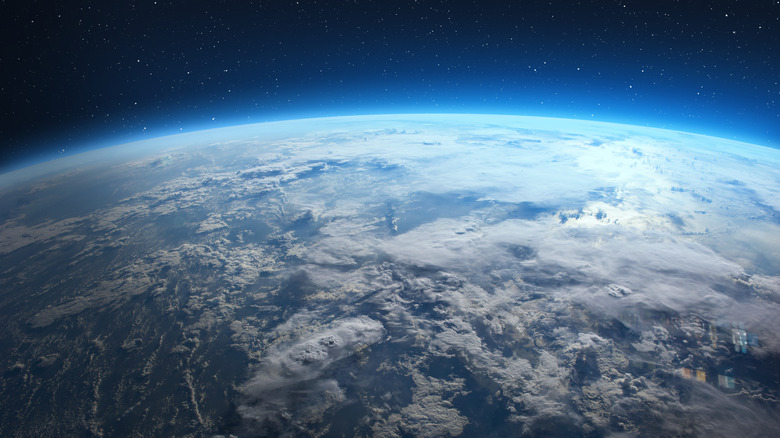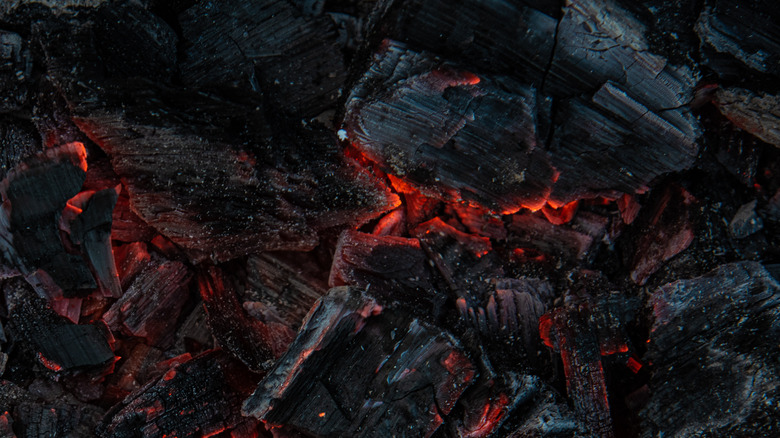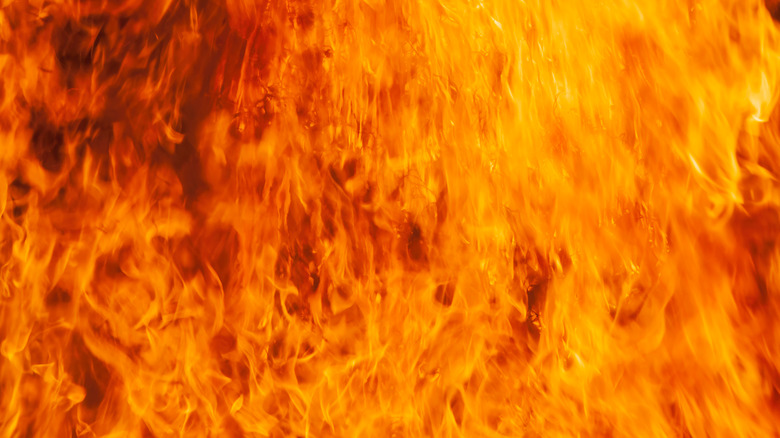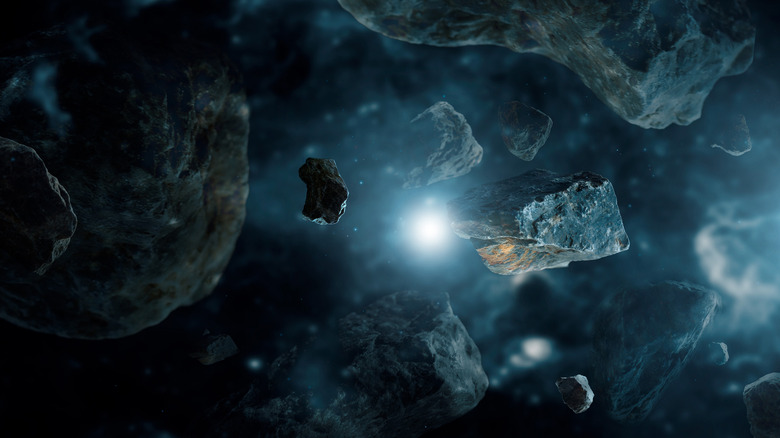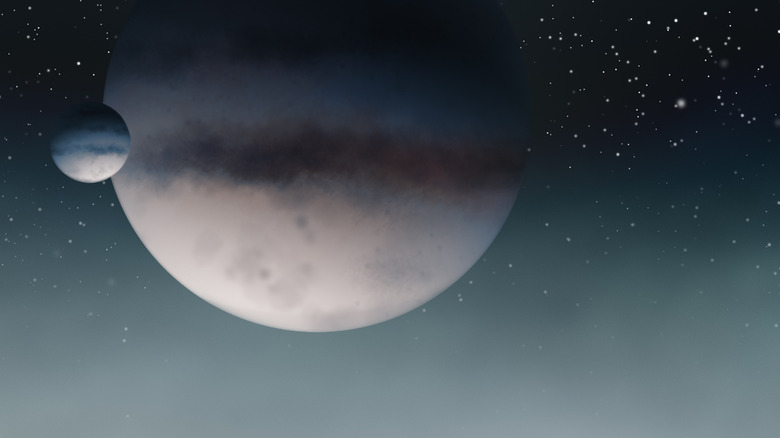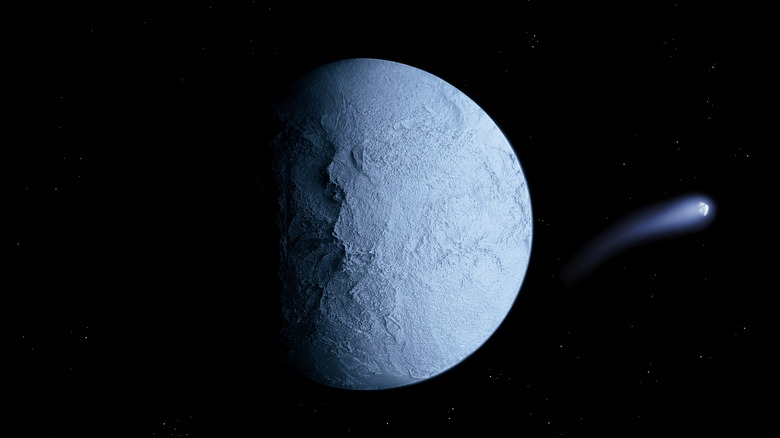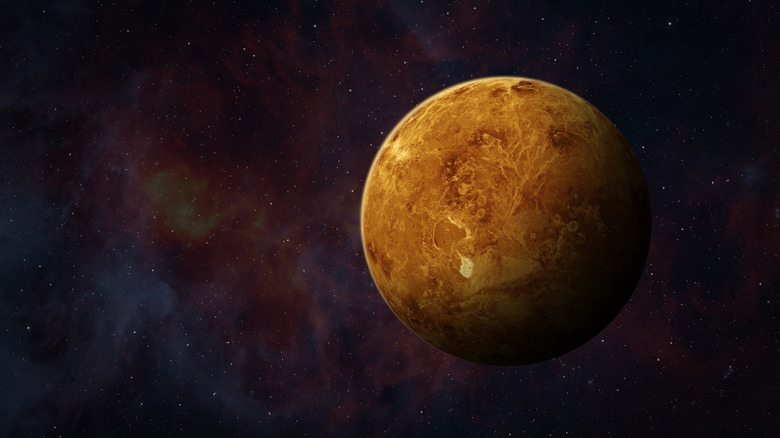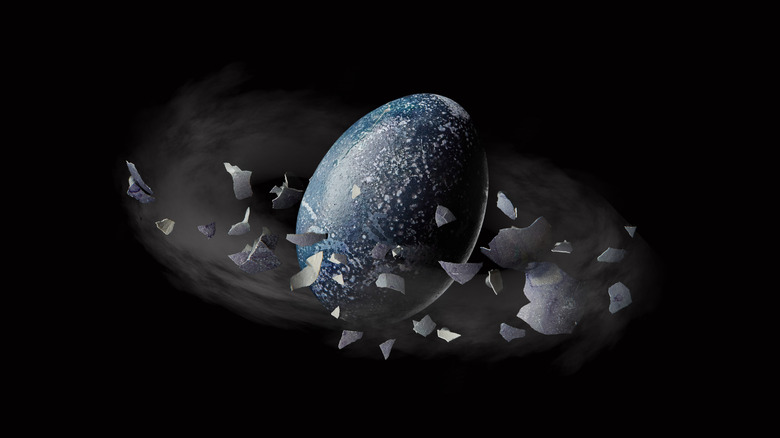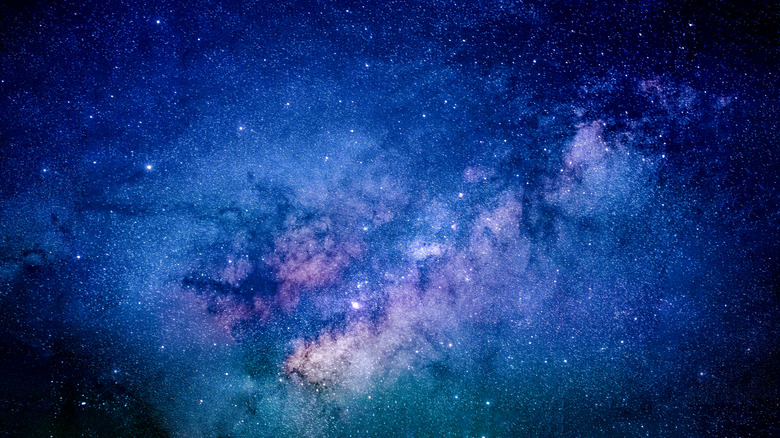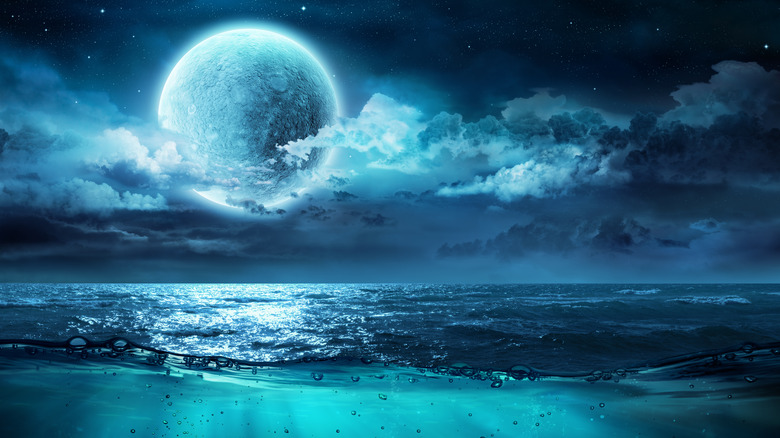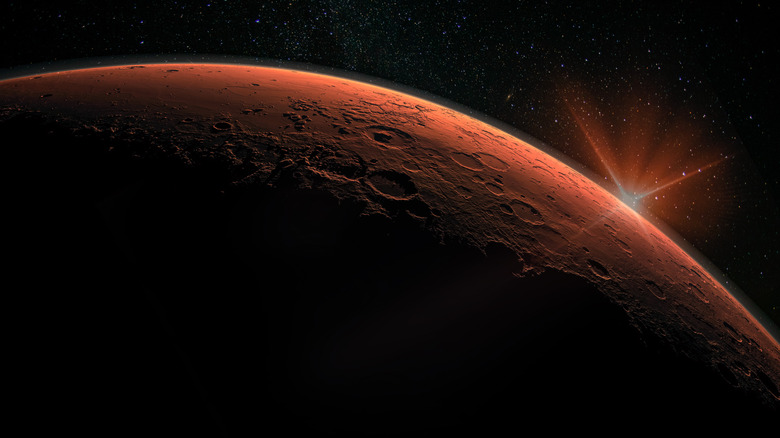The Scariest Planets We've Discovered So Far
There's really no better way to spend a hot summer night than relaxing in the great outdoors, looking up into a clear night sky. Without light pollution and interference from manmade nuisances like cities, it's not just a beautiful sight that unfolds above us, but it's pretty incredible, too.
According to Universe Today, anyone looking up at the night sky can — without the help of binoculars or a telescope — see things that are as far as 2.6 million light years away. Not only is that an almost unthinkable distance, Monash University astronomy professor Michael J.I. Brown points out (via The Conversation) that we're also looking back into the past. Light takes a while to travel to us, after all, so when we look up into the sky, we're not seeing things as they are, but as they were. That means we're seeing Andromeda as it was 2.6 million years ago, and that's some mind-bending stuff.
That night sky might look peaceful and a little vanilla, but all of those stars and planets have their own thing going on. And some of them? What's going on in their atmosphere and on their surface is the stuff not of a relaxing evening star-gazing, but of toxic atmospheres, impossible-to-imagine heat, and ice that burns. That's out there, too.
HD 189733b
Look to the northern sky and find the constellation Vulpecula — the little fox — and that's where you'll also find the planet with the distinctly un-catchy name of HD 189733b. If an observer was able to get a decently up-close and personal look, it would look sort of like another version of Earth. The planet, says Space, is a gorgeous, swirly blue orb, but that beautiful appearance is incredibly deceptive. NASA says the blue color doesn't come from oceans like it does on Earth; that's actually a reflection of clouds of airborne silicate particles. In other words? It's not just raining sideways, it's raining glass.
Sideways. That's not an exaggeration, either. The second part of HD 189733b's terrifying makeup is that it doesn't exactly do "light winds." It does constant winds at speeds averaging 5,400 mph. That's seven times the speed of sound, and just the thought of that is enough to make even the most dedicated amusement park fan realize that they need to give this world a hard pass.
As an interesting — and slightly less terrifying — footnote, it's also worth mentioning that this Jupiter-sized world is also flying through space. One year — i.e., trip around the sun — takes the equivalent of 2.2 days on Earth. Whee?
The OGLEs
There's no denying that seeing everyone's favorite Rebels fighting the bitter cold puts the ice planet Hoth in "The Empire Strikes Back" up there on the list of sci-fi planets that no one ever says they want to visit, but here's the thing: There's a real-world version of Hoth that's even more terrifying. NASA knows, says researchers from Jet Propulsion Laboratory (via CNN), because Hoth could at least sustain life; as unpleasant as conditions were, they were livable. The conditions on the planet designated as OGLE-2016-BLG-1195Lb are ... not-so-much.
Let's put it this way: Liquid nitrogen, says the BBC, boils at -321 degrees Fahrenheit. If someone were to be dumb enough to, say, stick a hand in liquid nitrogen, it would do pretty much what it does in the movies, which is to freeze solid and snap off. OGLE-2016-BLG-1195Lb is even colder than that, with an average temperature of around -400 degrees Fahrenheit.
The OGLE — which NASA says stands for the Optical Gravitational Lensing Equipment — telescopes have discovered other terrifyingly cold planets, as well. And the one called OGLE-2005-BLG-390Lb? The European Southern Observatory calls it "more Earth-like than any other planet found so far," but there's a major catch: the surface averages around -360 degrees Fahrenheit. Researchers suspect that it has a surface like Earth, but that it's buried under all kinds of frozen misery. Suddenly, Hoth doesn't look so bad.
TrES-2b
Afraid of the dark? Make it a point to never, ever go to the Jupiter-sized planet called TrES-2b. According to The Harvard Gazette, researchers aren't sure what's going on with this particular planet, but they do know that it reflects less than 1% of the light that hits it. That makes looking at the planet kind of like looking at a wall painted with matte black paints, and that's just weird — especially considering that it's so hot, it's too hot for cloud cover.
And here's the thing: Even though the atmosphere is filled with chemicals — like titanium oxide in a gas form — that absorb the light, it's not enough to actually explain what's going on here. The authors of a study on the planet say (via Space) that one of the likely explanations is a chemical that lowly Earth science doesn't know anything about. Princeton University's David Spiegel explains: "It's not clear what is responsible for making this planet so extraordinarily dark. However, it's not completely pitch black. It's so hot that it emits a faint red glow, much like a burning ember or the coils on an electric stove."
Wait, what? As if the sort of "Satan's soul" color scheme wasn't eerie enough, the planet is also insanely hot. Temperatures average somewhere upwards of 1,800 degrees Fahrenheit, which finishes off the whole fire-and-brimstone sort of look.
KELT-9b
There are a few things about KELT-9b that should sound familiar to Earthlings. It has four seasons, for example, and that's nice. What's not nice is that those four seasons are essentially two summers and two winters, and they're about nine hours long each. That's because the planet is so close to what Forbes calls the "host star" that a year is only about 36 hours long.
Oh — and that sun bombards the planet with 44,000 times the solar energy that Earth's sun gives it, and it's about 56% hotter than the sun. That all makes for a terrifying amount of heat. During the hottest hours, the planet's temperature hits up to 7,800 degrees Fahrenheit, and that means the atmosphere is caught in this vicious cycle of destruction. Those hottest temperatures are enough to literally tear molecules apart — according to Popular Mechanics, atoms like hydrogen form during the "cooler" seasons, then get superheated just a few hours later to be shredded like pulled pork. They'll reform later, and then the whole cycle starts over again.
Scientists feel fairly safe in saying that there's no chance life — of any kind — can exist there, and even if it did, it won't be existing for long. (Relatively speaking, of course.) The host star, KELT-9, is kicking off so much radiation that there's a good chance it's going to eventually vaporize little KELT-9b.
The planets of AU Microscopii
Most sci-fi movies and television shows have a scene that features characters trying to navigate a ship through an asteroid field, and there's a good reason for that — it's the kind of terrifying that makes your stomach seize up, even if you're sitting safely on the couch with a bag of Cheetos. Don't like all those close calls and near misses? Don't put the system of AU Microscopii on any bucket lists.
AU Microscopii is a baby red dwarf star, and as far as the universe goes, it's a pretty close neighbor to Earth at only about 32 light years away. Sky & Telescope says that the cool thing about the star is that it's surrounded by a debris field, and, naturally, astronomers have wanted to try to figure out just what caused this field of orbiting dust bunnies. Along the way, they discovered that the baby star already has two planets orbiting it ... inside the debris field.
As if that isn't bad enough, NASA describes the sun as consistently throwing "vicious temper tantrums," bombarding the planets with flares of radiation and X-rays. At least the debris field is visible, so that's a plus? Still, who would have thought that an asteroid belt would be the least frightening thing a planet needed to face in a day?
MOA-2010-BLG-477Lb
Everything, it turns out, has an expiration date — and that's true for our sun, too. According to Space, our solar system will come to an end in about 4.5 billion years, as the sun becomes more and more unstable and gets so bright that it turns all the nearby planets into crispy, deep-fried nuggets of nothingness. That's a bit of awfulness tempered by the fact that mankind probably won't be around to see it, but astronomers know exactly what it's going to look like: They've already seen a planet after the death throes.
National Geographic says that there's a Jupiter-sized planet in the system called MOA-2010-BLG-477Lb, which is about 6,500 light years away. It's still orbiting around a white dwarf, which is the remnants of a star that had previously been much like our sun ... before it expanded and destroyed all the planets closest to it — the same thing that's going to happen to our sun and solar system. Mercury and Venus will almost assuredly be incinerated, there's a lot of debate on what's going to happen to Earth. Incineration is a possibility, or, it might just be torn apart by gravitational forces.
Either way, it'll spell the end for our solar system — and the outer planets will be left like the survivor of MOA-2010-BLG-477Lb, drifting until they're simply ... not.
Gliese 436b
Mankind is built to accept certain truths, and when those truths get turned upside-down, it's more than a little disconcerting. Let's explain, with help from Gliese 436b. There are a few other scientific mysteries that make astronomers think they might not know nearly as much as they thought they did, starting with this: Gliese 436B has a temperature that's around 980 degrees Fahrenheit, and based on models, it should have a lot of hydrogen and methane. Only, it doesn't — and no one knows why. And then, says Futurism, there's the very hot ice, and hot ice is precisely the sort of oxymoron that makes human brains uncomfortable.
Here's what little is known. Gliese 436b isn't a gas giant (like Jupiter), and it's not a solid planet (like Earth). Instead, it's made up of something called Ice-x. This weird stuff is basically water that's condensed into ice by the planet's extreme gravitational pull. It's so strong that it keeps the water in ice form, in spite of being the sort of temperature that could melt skin right down to the bone ... and then, keep on melting.
And don't worry, it gets even more mind-melting. Gliese 436b is so close to the star it orbits that, according to EarthSky, the atmosphere is being heated to the point where it's evaporating and giving the planet the appearance of having a comet-like tail. None of this plays nice with science, and scientists, well, they like it when things make sense.
Venus
It turns out that one of the most terrifying planets astronomers have discovered is right here in our own solar system, and that's Venus. It might be named for the Roman goddess of love, but it's anything but lovely. There's a lot going on here, too, so let's hit the main talking points, starting with the fact that it's the hottest planet in the solar system.
Venus has temperatures that regularly hit up to 870 degrees Fahrenheit, and while that's amateur hour compared to some other planets, it's enough to make some weird stuff happen. The planet's atmosphere is so dense it wouldn't be wrong to think of it as an entirely separate entity, particularly because it rotates at about 60 times the speed of the planet. That, says Space, is what causes the weird vortex storm that's roughly the same size as Europe and has been raging over the south pole for who knows how long. And storms aren't pleasant. The rains aren't water; they're sulfuric acid, as Gizmodo notes.
There's also somewhere around 1,600 volcanoes scattered across the planet, and then there's the very uncomfortable fact that a year passes faster than a single day. Winds reach speeds of up to 450 mph, and oh — they're also electrified. The electric field surrounding the planet is so strong that it's thought to be what causes these winds, which are described as less like Earth's winds and more like ... well, imagine solar flares combined with lightning.
WASP-12b
Life is really nothing but the relentless onward march toward death, and most people don't like to be reminded of that sort of thing. Still, it's what makes us human ... right?
Right? It turns out we're not exactly all that special after all, and astronomers have been watching the slow "death spiral" of a planet called WASP-12b for a while now. It's not only inevitable, but if it was the kind of fate that happened to a human, most would want to look away. WASP-12b is a gas giant, and it's about twice the size of Jupiter. It also orbits its star so fast that a year lasts just about a single Earth day — and, it's speeding up. It's also absorbing more and more heat as it spins. All of those factors mean that it's essentially tearing itself apart very, very slowly ... although, not as slowly as it was once thought. According to Popular Science, astrophysicists once gave the planet about 10 million years left to live, and that's been dropped down to around 3 million.
While researchers are still studying the planet to determine just what's causing the death spiral, there's another eerie footnote. According to NASA, they can see the effects of gravitational forces: They're stretching the planet out into the shape of an egg.
Planet Nine
The so-called Planet Nine is a little different, in that it hasn't been discovered yet. Precisely. Well ... kind of. What has been discovered, says the BBC, is a mysterious mass on the edge of our solar system. It's so big that it seems to be pulling other things toward it, but no one's 100% sure what "it" is.
Let's go all the way back to the start, with Percival Lowell. Lowell was a man of the future, and much like the 21st-century person who reads a Facebook post and thinks they're an expert, Lowell read a book about Mars and thought he was an astronomer. Among his theories was one that an unidentified "planet X" was responsible for irregularities in the orbits of the outer planets, and, well ... today, some think he was right. Large bodies beyond Pluto have been observed following similar irregularities, and in 2016, a pair of Caltech researchers proposed the existence of Planet Nine. It's a planet somewhere between five and 10 times the size of Earth, with a gravitational pull that's engaged in a sort of tug o' war with the sun for bodies in the outer solar system.
So, how on Earth has everyone managed to miss a whole planet? According to National Geographic, the reason no one's seen it might be almost painfully obvious: it simply blends into the background of the Milky Way. So if that's true and Planet Nine is drifting in plain sight ... what else is hiding out there?
GJ1214b
The only thing more frightening than the possibility that Earth — a planet inhabited by beings that are sentient at least part of the time — is alone, is that it's not alone. The questions around the possibilities of extraterrestrial life have been asked from the first night someone looked up into the night sky and wondered what was up there, and according to a team of researchers from the Harvard-Smithsonian Center for Astrophysics, they got a little closer to the answer in 2009 with the discovery of GJ1214b. That, says The New York Times, is the designation given to a distant world researchers called "the most watertight evidence so far for a planet that is something like our own Earth."
The surface is something out of the movie "Waterworld," and yes, it's mostly water. It's not great for swimming, though, as the planetwide ocean has a surface temperature of around 400 degrees Fahrenheit. The atmosphere is superheated steam and a mix of other gases, and even though the word "superheated" doesn't sound promising, it's so much cooler than most of the other comparable planets found that, should push come to shove, it might not start sounding so bad as an alternate Earth.
There are always those party-poopers who insist that there's nothing even remotely close to Earth out there, and GH1214b? It proves them wrong ... for better, or worse.
HD 80606b
Anyone who's had a severe case of whiplash can attest to the fact it isn't pleasant, and anyone living on HD 80606b — if it were habitable, that is — would have a seriously shocking case of whiplash every 111.8 Earth days. That's how long it takes the planet to orbit its star, the predictably-named HD 80606. Little b has an incredibly unusual orbit which takes it from 79 million miles away from the star to just 2.8 million miles away on the other side. (For a reference, Space says that Earth is around 93 million miles from the Sun, depending on the orbital position.)
As the little planet gets to the point in its orbit closest to the sun, temperatures skyrocket by around 1,300 degrees — all the way up to about 2,060 degrees Fahrenheit, says Sci-News — over the course of just six hours, or the time it takes to watch almost two whole movies in the "Lord of the Rings" series. Temperatures max out as the planet catapults around the sun, and just as shocking is the temperature drop. Within just about 10 hours, it cools off enough that it becomes invisible to the Infrared Array Camera on the Spitzer Space Telescope at NASA.
Sky & Telescope explains the insane temperature shift like this: It's in the 80s most of the time, but one morning it's 1,000 degrees during the morning commute, it's 2,200 degres by the time you're coming back from lunch, and then, it's back into the 80s.

